
Starman is a name used by several different DC Comics superheroes, most prominently Ted Knight and his sons David and Jack.

L.E.G.I.O.N. is a science fiction comic book created by Keith Giffen, Bill Mantlo and Todd McFarlane and published by DC Comics. The principal subject of the comic book is a team of fictional extraterrestrial superheroes. The characters first appeared in Invasion! #1. The original series chronicled the formation and activity of an interplanetary police force whose mission was to act as a peace-keeping force in their galaxy.
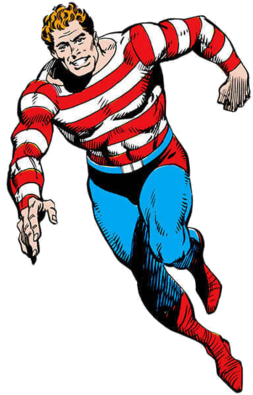
S.T.R.I.P.E. is a superhero in the DC Comics Universe. S.T.R.I.P.E. is a powered armor suit invented and worn by Patrick "Pat" Dugan, the former adult sidekick to teenage superhero Sylvester Pemberton, the Star-Spangled Kid. "Stripesy", as he was originally called, is a gifted mechanic who built the Star Rocket Racer, a bubble-topped limousine with the functions of a rocket and helicopter. Together, they were members of the Seven Soldiers of Victory and the All-Star Squadron. Stripesy was created by Jerry Siegel and Hal Sherman, and first appeared in Star Spangled Comics #1.

Kamandi is a fictional comic book character created by artist Jack Kirby and published by DC Comics. The bulk of Kamandi's appearances occurred in the comic series Kamandi: The Last Boy on Earth, which ran from 1972 to 1978.

Samuel Emerson "Slam" Bradley is a fictional character that has appeared in various comic book series published by DC Comics. He is a private detective who exists in DC's main shared universe. The character concept was created by DC Comics founder Malcolm Wheeler-Nicholson and developed by Jerry Siegel and Joe Shuster, who both later became more well known as the co-creators of Superman. As one of the first ever DC characters, the character first appears in the Golden Age of Comic Books in the anthology title Detective Comics, being introduced in the first issue. He later commonly was associated with Batman and other spinoff Batman characters when revived.

Rene Jacques "R. J." Brande is a character appearing in DC Comics, primarily in association with the Legion of Super-Heroes. He first appeared in Adventure Comics #350, and was created by E. Nelson Bridwell.
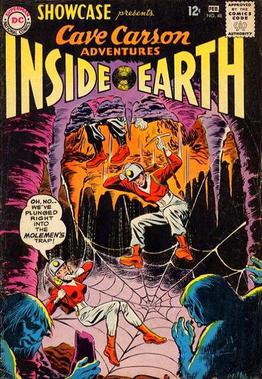
Calvin "Cave" Carson is a fictional character that appeared in stories published by DC Comics. Carson, a spelunker, first appeared in Brave and the Bold #31 ; he was created by France Herron and Bruno Premiani.
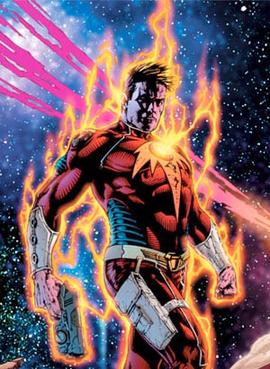
Captain Comet is a superhero appearing in American Comic Books published by DC Comics, created by editor Julius Schwartz, writer John Broome, and artist Carmine Infantino.
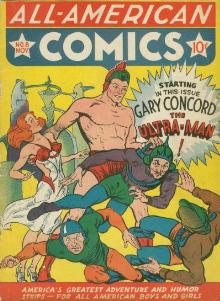
Ultra-Man is the name of two fictional comic-book superheroes, father and son, that first appeared during the 1940s, the period fans and historians call the Golden Age of comic books. Both were characters of All-American Publications, which merged, in 1946, with DC Comics-predecessor National Periodical Publications.

Anthro is a fictional superhero character published by DC Comics, presented as the "first boy", a caveman born to Neanderthal parents. Anthro was created by cartoonist Howard Post; he first appeared in Showcase #74.

Space Ranger is a science fiction hero who was published by DC Comics in several of their 1950s and 1960s anthology titles. He first appeared in Showcase #15 and was created by writers Edmond Hamilton and Gardner Fox and artist Bob Brown. The character has notable similarities to a preceding character named David "Lucky" Starr, created by novelist Isaac Asimov in his 1952 novel David Starr, Space Ranger. After appearing in Showcase #15 and 16, the Space Ranger was given a cover-starring series in Tales of the Unexpected, starting with issue #40 and lasting until #82 (1959–64). Afterwards, he moved to Mystery in Space.

Ultra the Multi-Alien is a science fiction superhero featured in comics published by DC Comics. He first appeared in Mystery in Space #103 (1965), pushing out Adam Strange and Space Ranger from that title. He was created by writer Dave Wood and artist Lee Elias.
Space Cabbie is a science fiction character in DC Comics.

Sylvester Pemberton, alternately known as The Star-Spangled Kid and Skyman, is a superhero in the DC Comics universe. Sylvester first appeared in Star Spangled Comics #1 and was created by Jerry Siegel and Hal Sherman.

The Black Pirate is a fictional character from DC Comics, created by Sheldon Moldoff. He first appeared in Action Comics #23. His ghost played an important role in James Robinson's 1990s Starman series.
Scalphunter is a fictional character, a Wild West hero in the DC Comics Universe. Scalphunter first appeared in Weird Western Tales #39 and was created by Sergio Aragones and Joe Orlando.
Space Museum was a science fiction comics series published by National Comics in their flagship science fiction title Strange Adventures between 1959 and 1964. The series was written by Gardner Fox and was drawn by Carmine Infantino for almost the whole series.

Darwin Jones is a fictional character appearing in media published by DC Comics. He first appeared in Strange Adventures #1, and was created by David V Reed and Paul Norris.
Jack Schiff was an American comic book writer and editor best known for his work editing various Batman comic book series for DC Comics from 1942 to 1964. He was the co-creator of Starman, Tommy Tomorrow, and the Wyoming Kid.
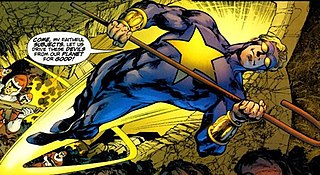
Starman (Prince Gavyn) is a superhero in DC Comics, as one of several heroes called Starman within the DC Universe. Created by writer Paul Levitz and designed by artist Steve Ditko, the character debuted in Adventure Comics #467 in November, 1979 (cover dated January 1980). The character appeared in only 13 stories between 1979 and 1981. In 1986, he was briefly mentioned in the crossover comic Crisis on Infinite Earths as having recently died while trying to protect his native planet. Prince Gavyn's story was expanded in a later Starman comic book series published from 1994 to 2001 that focused on the hero Jack Knight and revisited all DC characters who had used the Starman name. The same series reveals Gavyn's life energy survives in the body of Will Payton, another DC Comics hero called Starman.
















